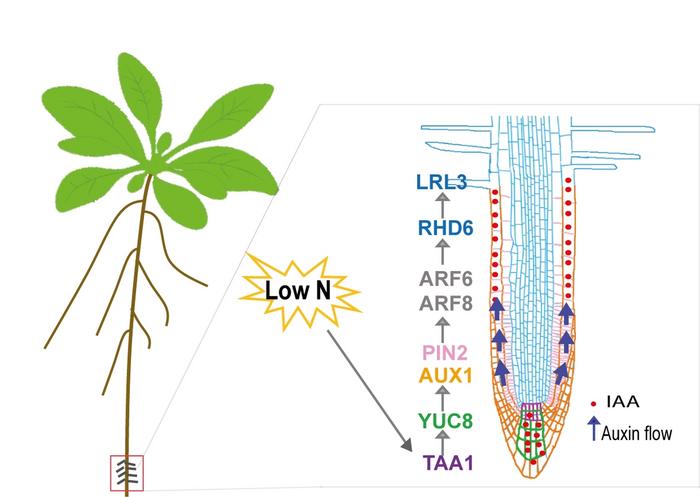Plants have evolved diverse adaptive strategies to optimize the exploration of light and soil resources from their environments. One of the most prominent adaptive responses is the developmental plasticity of their root systems, which enables plants to efficiently forage nutrient pools that fluctuate in space and time. As a crucial component determining the active root surface, root hairs represent a powerful morphological trait to improve water and nutrient acquisition. Root hairs are extensions of epidermal cells that effectively enlarge the root surface area and facilitate soil exploration for water and nutrients. Root hair development starts with cell fate specification, which determines whether an epidermal cell becomes a hair-forming cell (trichoblast) or a hairless cell (atrichoblast).

Credit: IPK Leibniz Institute
Plants have evolved diverse adaptive strategies to optimize the exploration of light and soil resources from their environments. One of the most prominent adaptive responses is the developmental plasticity of their root systems, which enables plants to efficiently forage nutrient pools that fluctuate in space and time. As a crucial component determining the active root surface, root hairs represent a powerful morphological trait to improve water and nutrient acquisition. Root hairs are extensions of epidermal cells that effectively enlarge the root surface area and facilitate soil exploration for water and nutrients. Root hair development starts with cell fate specification, which determines whether an epidermal cell becomes a hair-forming cell (trichoblast) or a hairless cell (atrichoblast).
“In our study, we first showed that nitrogen deficiency strongly stimulates root hair elongation in the model species Arabidopsis thaliana and that this response is crucial for plant fitness under low nitrogen”, explains Prof. Dr. Nicolaus von Wirén, head of the department “Physiology and Cell Biology” at IPK Leibniz Institute. “And we then integrated transcriptomics, molecular genetics and cell biology approaches to establish that low nitrogen-induced root hair elongation builds on a spatially coordinated auxin signaling cascade that enters the root hair developmental program via the epidermal transcriptional module RHD6–LRL3.”
The signaling cascade consists of three stages. Through upregulation of the enzymes TAA1 and YUCCA8, low nitrogen increases auxin accumulation in the root apex (step 1, synthesis). Auxin is then directed shootward to the root hair differentiation zone via the transporters AUX1 and PIN2 (step 2, transport). Upon arrival, auxin activates the transcription factors ARF6 and ARF8 to promote the transcriptional module RHD6–LRL3, which is confined to the epidermis and steers root hair elongation in response to low nitrogen (step 3, signaling).
“Overall, our results suggest that root hair elongation represents an additional systemically-induced foraging response strategy to explore the soil for nitrogen, gaining even more relevance as nitrogen deficiency becomes more severe”, says Dr. Zhongtao Jia, first author of the study. “These findings add a new feature to our understanding of root foraging responses in low-nutrient environments and expand the mechanistic framework of hormone-regulated nutrient sensing in plant roots.”
Since more abundant and longer root hairs represent a low-cost strategy for plants to bring roots in contact with soil nutrients, understanding how root hair development is regulated by nitrogen provides new breeding targets for developing crops with enhanced nitrogen-uptake efficiency.
Journal
Current Biology
DOI
10.1016/j.cub.2023.08.040
Article Title
A spatially-concerted epidermal auxin signaling framework steers the root hair foraging response under low nitrogen
Article Publication Date
11-Sep-2023




